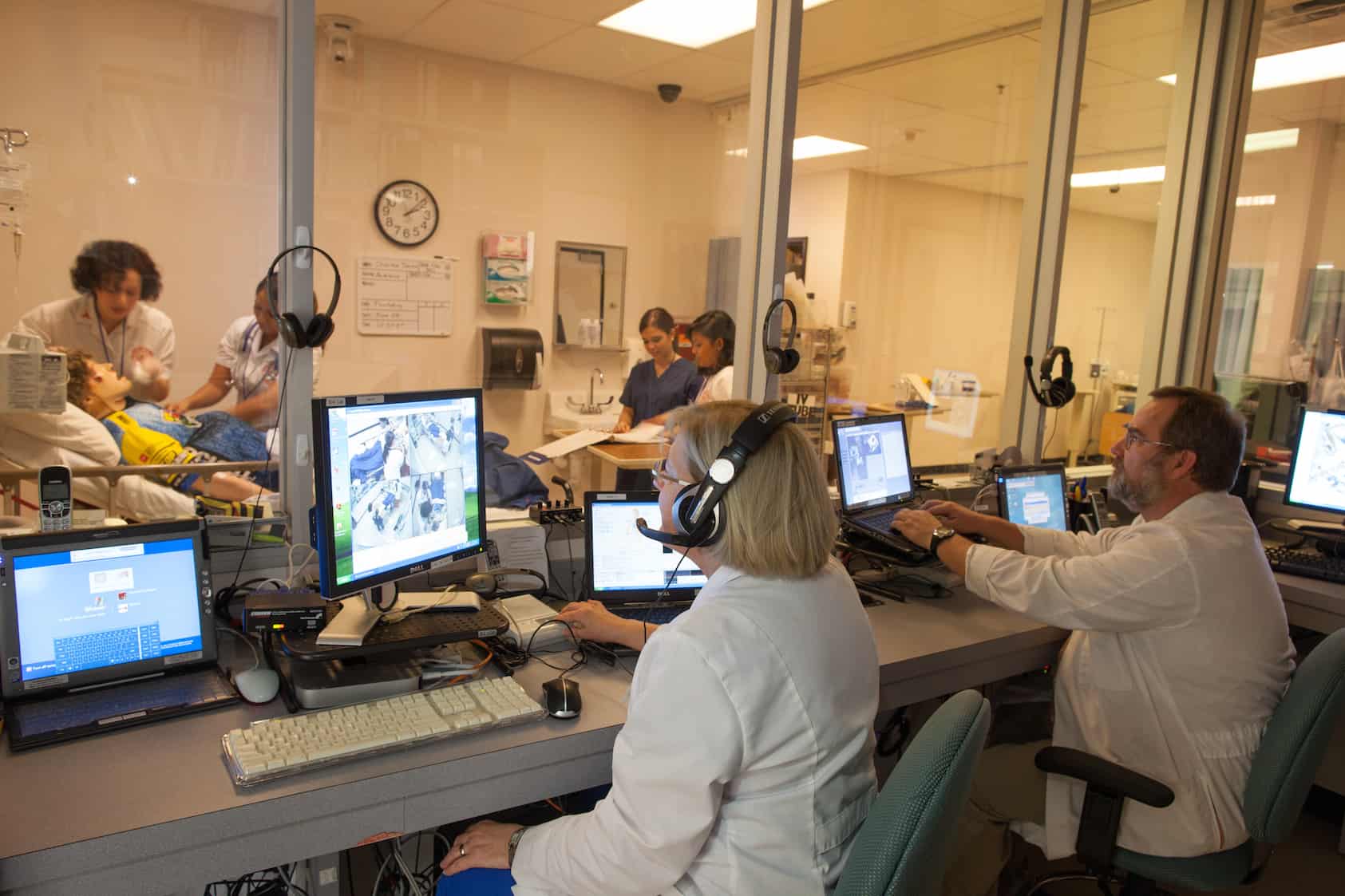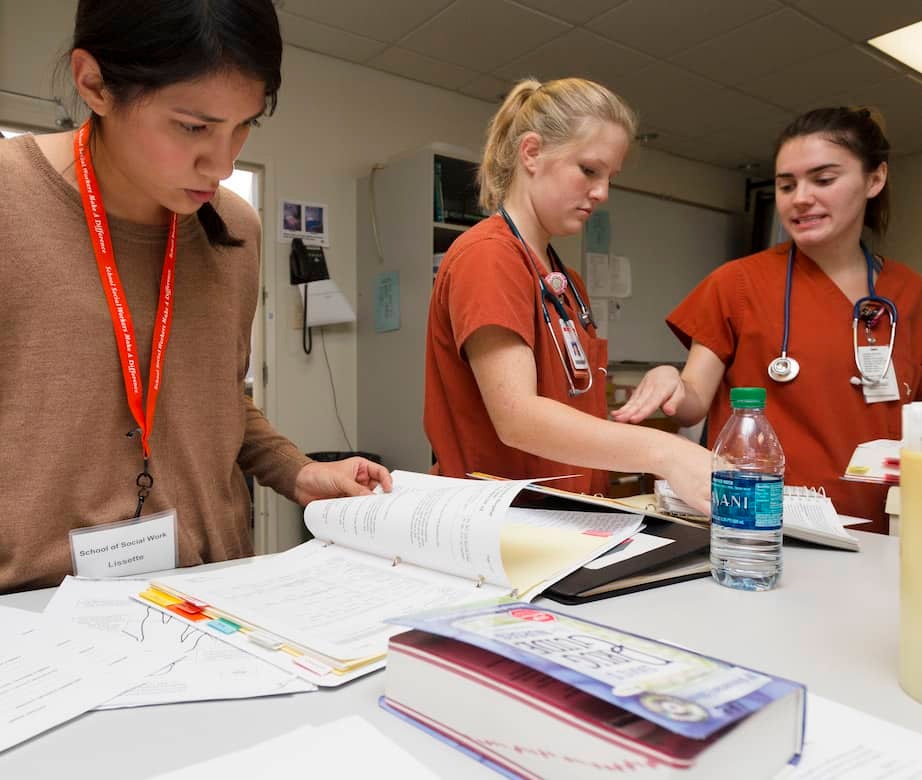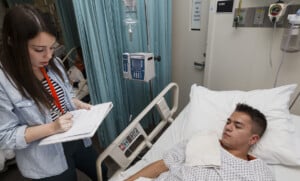Social work students participate in interprofessional healthcare simulations
A distressed hospital patient in his fifth day of alcohol detox complains of headache and tremors and demands medication as several nurses swarm around trying to figure out what is the best course of action. A social worker is called in, and she momentarily soothes the patient with a breathing exercise. Soon, however, he starts demanding medication again.

The scene was part of a detox simulation for nursing and social work students at The University of Texas at Austin this past spring. The patient was in fact a mannequin, expertly managed from the control room by Scott Hudson from the School of Nursing’s SimLab. Hudson, who also provided the patient’s voice, improvised in accordance with a standardized detox scenario. Students could take the patient’s vitals, see symptoms such as trembling hands on an attached monitor, and have a real-time dialogue that required them to think on their feet, problem-solve, and make critical decisions under pressure.
As interprofessional education gets momentum on the Forty Acres, new opportunities like this detox simulation have opened for students from social work, nursing, pharmacy, and other health-related professions to train together.
“Teamwork is essential for the delivery of good integrated healthcare, and we must teach this aspect to students in the health-related professions from early on,” said Barbara Jones, assistant dean for health affairs at the School of Social Work.
“Students need to learn about their own and other professions’ scope of practice, principles, ethics, and values, so that when they begin their careers they are already comfortable with interprofessional collaboration,” Jones added.
In the 2014-2015 academic year alone, social work students have participated in several hospital simulations, a mock disaster drill, a standardized patient training to address substance abuse, and a poverty simulation.
“In addition to teaching them to work in interprofessional teams, these opportunities allow our students to test their skills in very realistic and challenging conditions and to receive feedback, before they work with actual clients,” said social work professor Mary Velasquez.

Velasquez is the director of the School of Social Work’s Health Behavior Research and Training Institute, which runs a standardized patient training for social work students to address substance abuse. During this training, actors portray patients who discuss specific symptoms with students according to a pre-established scenario, while expert coaches observe the interaction and provide immediate feedback after the session is over.
“Our standardized patient training model is the only one of its kind and is fashioned after the clinical examinations taken by medical students and resident physicians. This experience further enhances the commonalities of experiences among the inter professional team members,” Velasquez added.
At the detox simulation described above, the interweaving of practice and feedback was also carefully orchestrated to maximize the students’ learning experience.
The simulation lasted a full day, in which the patient progressed from day one to day seven, and discharge from the hospital. At each stage, he was cared for by a different group of students.
Before releasing each group to the SimLab, nursing professors Charlotte Wilson and Jammie Rock with the help of social work professor Robin Smith guided the whole class in a discussion of which symptoms could be expected at each stage of the detox process for this particular patient, who happened to be homeless, middle-aged, and not particularly willing. Students also listened to a recorded report on how the patient had done during the previous stage, and what medications he was taking.
Once a group was released to the SimLab, the teachers and the rest of the class were able to observe the scene in real-time on a screen. When the group was finished, the student came back to the classroom to debrief, and everyone discussed what went well and what could be done better.

“We are still working on formally including social work in the standardized scenario, but in the meantime the nursing faculty have been wonderful at improvising and integrating our students in the simulation,” Smith said.
Smith is the coordinator of the School of Social Work’s Integrated Behavioral Health (IBH) Scholars program, which prepares master’s level students to work in health care settings that serve the needs of underserved populations. IBH Scholars must take a semester-long interprofessional course, a course on Motivational Interviewing (a counseling method that has a strong-evidence base for effective use in medical settings), complete their internships in integrated clinics, and participate in interprofessional trainings like the ones described here.
“Everything is very realistic in the training area,” said Esmirna Corona, one of he IBH Scholars who participated in the detox simulation. “I was able to apply everything I have learned in school about the dynamics of an interprofessional team. I also found it very useful to recognize how important social workers are to the team: I had the opportunity to play an active role in the simulation by providing behavioral interventions once the doctor did not approve further medications.”
“There were times when I went into the simulation with a particular agenda but ended up finding that the agenda didn’t meet the patient’s need at that point in detox,” said Mikaela Frissell, another IBH Scholar. “It reminded me of the importance of staying flexible and responsive to the patient’s perspective.”
Back at the detox simulation, the last group of students was getting ready for the final scene, which involved the patient’s discharge despite his high levels of anxiety and his trepidation about going back to the uncertainties of his homeless life. As they were reviewing discharge procedures such as assessing for suicide ideation, one of the nursing students looked eagerly at Wilson and asked “Can we have the social worker in our team?”
Posted June 2, 2015. By Andrea Campetella

